2016
Long-term Cropping Study – Composted Beef Manure
In 1987, a long-term cropping systems study started at the NDSU Carrington Research Extension Center. Three sets of 4-year crop rotations are replicated three times each year. The eighth cycle ended in 2015. A discussion on tillage systems can be found here and the economics of the system can be found here. For this blog post, we’re going to discuss some of the effects of using composted beef manure on soil properties and selected crop yields. This study is located on a Heimdal silt loam soil. The main plots are 180 ft. by 300 ft. so field scale equipment is used.
The fertilizer treatments are: (1) urea broadcast applied each spring to all plots, except field peas and soybeans, at 0, 50,100, or 150 pounds of N per acre and (2) composted beef feedlot manure applied once at 200 pounds of N the first year of each 4-year cycle (once every four years). These treatments are imposed in strips perpendicular to the three tillage systems: conventional, minimum tillage, and no till resulting in 12 sub-plots within each crop.
The plots are soil sampled every year and phosphorous and sulfur were blanket applied to all non-manure plots when they fell out of the medium test range.
Here’s what we’re seeing:
- Composted manure plots have significantly higher soil organic matter content1. As you might expect, the increase in soil organic matter is due to the additional carbon compounds provided in the composted manure.
- Composted manure plots have significantly higher soil pH2. The increase in pH is, again, due to the additional organic matter found in manure. Chemical reactions in the soil as the urea changes into available forms of N increase the acidity of soil (lower the pH).
- Field pea shows a significantly higher yield (9.7 bu/acre increase) along with soybean (5.8 bu/acre increase) on composted manure. Again, this improvement is likely due to several factors stemming from higher organic matter:
- Increased water availability due to increased water holding capacity.
- Luxury levels of phosphorous available in the composted manure plots, which is important in nitrogen fixation of the nodules.
- Increased nitrate nitrogen due to organic matter mineralization made available for both crops later in their growing season when nitrogen demand to fill pods and seeds exceeds nitrogen fixation capacity from root nodules.
Composted beef feedlot manure is an excellent economical fertilizer if available. Crop yields are equal to and some times greater than equivalent amounts of commercial nitrogen fertilizer. Find out more about the economics here.
The goal of the study is to determine the effects of tillage system, N fertility level and source, and crop rotation and the combination of these parameters have on crop grain and biomass production, crop diseases, soil nitrogen, soil phosphorous, soil organic matter, and soil pH. The study at the CREC is only study of its kind in North America to our knowledge.
Ezra Aberle
Agronomy Research Specialist
1 Soil organic matter content: Composted manure at 3.8%. 100 lbs. urea at 3.6%. 50 lbs. urea at 3.5%. No fertilizer at 3.3%.
2 Soil pH: Composted manure at 7.2. No fertilizer at 6.6. 50 lbs. urea at 6.4. 100 lbs. urea at 6.0.
CREC Niche Seed Crop
Buckwheat has been and is again a niche seed crop grown within the CREC’s foundation seedstock program. The variety Manor was already part of the seed increase program back in the 1980’s. Fresh out of college, I was employed as a technician in the seed program. My memory of buckwheat is still the same, potentially having a lot of plant mass coming through the windrower opening when swathing and then having limited remaining straw after combining. After a few years of foundation seed production and declining seed sales, a decision was made to discontinue further seed increases.
About 20 years later, in the early 2000’s, growers asked if we would start growing buckwheat again to provide a source of pure seed. In 2003 the CREC initiated a new increase with a 12 acre planting since seed was very limited. Because of customer demand, our acreage has steadily increased over the years to the 80 to 90 acres which we generally now grow and condition. Over the course of the past 14 years the CREC has maintained an inventory of foundation grade seed for sale. Within this cycle of Manor buckwheat seed production there has only been three years that the crop has not been produced. In those three years the combination of carryover inventory and seed demand warranted no need for additional plantings.
The variety Manor is an old public variety where seed can be purchased without a contract that may be required if sourced from a private company. Even though this is an older variety, it is still shown to be competitive with yields of other varieties. Our seed typically is in demand by customers who have connections to the organic markets.
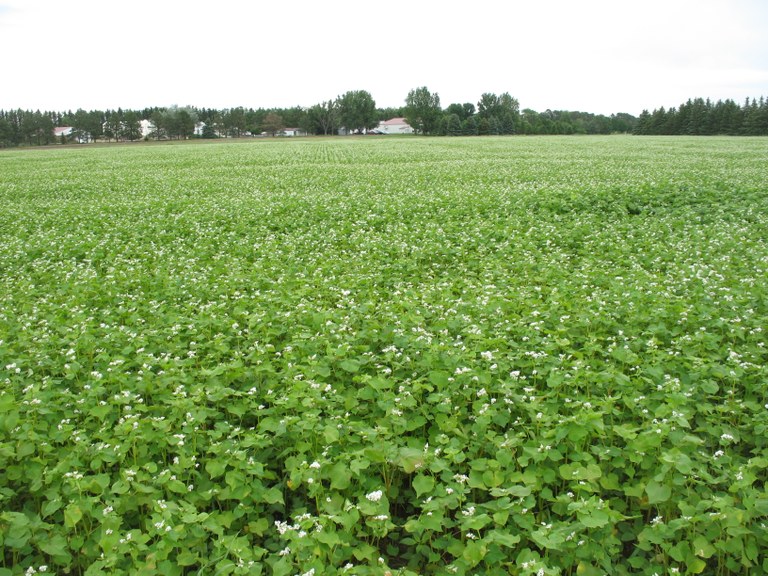
Manor Buckwheat
Buckwheat is a warm season crop that is very sensitive to frost and as such spring and fall frost dates are critical. The planting dates we have used across the years of our seed increase fields have ranged from May 22nd to June 13th. As we review our production through the years we see our best performance coming from planting dates around the 24th to the 28th of May. The timing of a heat or drought stress can have a big impact on flowering time and duration which in turn seems to determine the yield. In our seed increase program, we typically plant about 50 # of seed per acre and at a seeding depth of 1 to 1.5 inches. A firm seedbed is needed to help ensure fast emergence and rapid plant growth. This is essential to help compete with weeds. A heavy pounding rain after planting can cause crusting issues with delayed, uneven emergence. For more information on buckwheat production you can review the Buckwheat Production guide available from the NDSU Extension Service.
Dave Copenhaver
Seedstocks Research Specialist
What Should I Do With My Calves?
As the calendar turned to October, you have probably noticed the discussion about the falling feeder cattle markets this fall, which lead to the question of what everyone planned to do with their calves. There were more than likely many different theories from those who were going to sell as soon as possible right off the cow to those who planned to stick with the status quo and do the same as they have for many years. In my office, phone calls about whether or not to background calves were almost as popular as the calls about crop land rental rates, and both of those questions were equally hard to answer.
The November Feeder Calf Contract fell from the 190/cwt range a year ago to the current level of under 130/cwt. Those changes in the market have caused a drastic difference from where we sat a year ago, and have made the question of what to do with the calves a hot topic.
When deciding whether to sell the calves a weaning or to background to a certain weight, a producer must consider their available resources of feed, pen space, and labor. These items along with the knowledge of how their cattle perform on feed are very important when making the decision.
Currently if a producer were to wean 550 pound calves with plans to feed them for 90 days and for them to gain 3 pounds a day at 45 cents of feed cost per pound of gain, the breakeven selling price at the end would be around $124/cwt. If the cost of feed were to go up to 50 cents per pound of gain, the breakeven price becomes $126/cwt. Just a small increase in costs can make a large difference in the price needed on sale day.
Producers looking to make this decision based on their own numbers can certainly call with any questions. Additional data and breakeven price tables will be available at www.ndfarmmanagement.com.
Jory Hansen
Farm Business Management Instructor
2016 Crop Variety Data Available on Web
Carrington Research Extension Center (CREC) 2016 early season crop variety trial data are available at the website: www.ag.ndsu.edu/varietytrials/carrington-rec/2016-trial-results
Crops include winter wheat, rye and triticale; spring and durum wheat; barley; and canola. Hail was received at the CREC on July 9 that reduced yield and increased variability among varieties tested in the trials. For example, the dryland spring wheat variety trial at Carrington averaged 33.6 bushels/acre, with a range of 23.7 to 39.3 bushels/acre.
Off-station spring wheat variety trials show exceptional seed yield plus adequate protein. Hard Red Spring (HRS) wheat trial yield at Dazey (pictured below) averaged 76.8 bushels/acre with 9 highest-yielding varieties (Faller, HRS3361, HRS3419, HRS3530, Prosper, Shelly, Surpass, SY Valda and WB9507) at 82 to 89 bushels/acre. Tri-county (Wishek) HRS wheat trial yield averaged 72.8 bushels/acre with five highest-yielding varieties (Faller, Linkert, Prosper, SY Valda and WB9507) at 80 to 88 bushels/acre.
Check the website periodically for data from additional trials.
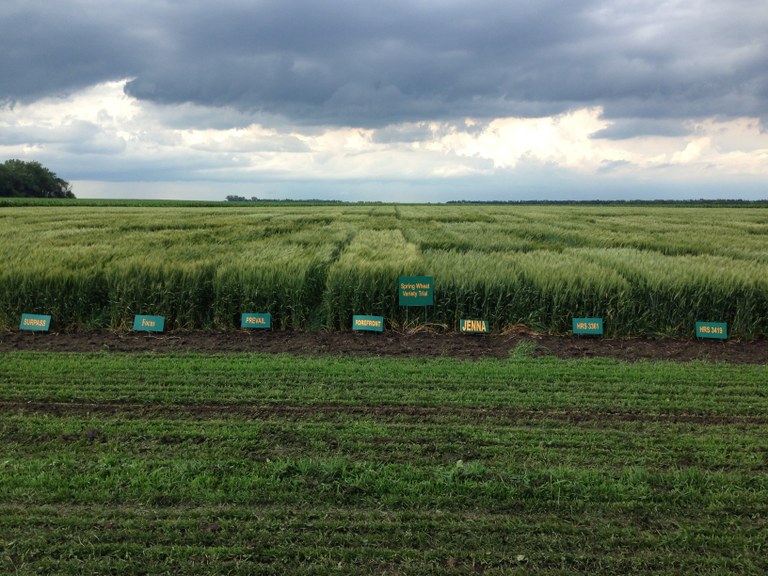
Greg Endres
Area Agronomy Specialist
Another Reason to Quit Mowing
In the fall, pollinators like bees, moths, butterflies, flies and wasps, and insect predators are stashing away nutrients to help them survive the winter. Wild bees can increase the production of crops 15-50% over honeybees alone! Even soybeans see a 10-50% increase in production if bees are present in the fields. However, wild, super-efficient pollinators have declined in numbers all across the world due to many factors, but primarily due to habitat loss. (70% of bees are solitary and live in the ground.)
One small thing that we can do is let ‘unused’ places and little corners be a little wilder. You can do this by considered neglect or by planned methods. Do it in your yard. Do it on the edges of your fields and paths. Let clover grow in your lawn. Wait to mow until everything is dormant. Just do less. Crops of all kinds will produce better when wild pollinators are part of our landscape.
Following are links to some useful follow-up information:
- Wildlife Conservation on Farmland Volume 1: Managing for nature on lowland farms. How can Field Margin Management Contribute to Invertebrate Biodiversity? Feber, Johnson, Tattersall, Manley, Hart, Smith, Macdonald. Link
- Native wildflower plantings support wild bee abundance and diversity in agricultural landscapes across the United States. Williams NM, Ward KL, Pope N, Isaacs R, Wilson J, May EA, Ellis J, Daniels J, Pence A, Ullmann K, Peters. Ecological Applications, 2015. Link
- Functional group diversity of bee pollinators increases crop yield. Hoehn P, Tscharntke T, Tylianakis JM, Steffan-Dewenter I. Proc. Biol. Sci., 2008. Link
- Wildlife-friendly farming increases crop yield: evidence for ecological intensification. Pywell RF, Heard MS, Woodcock BA, Hinsley S, Ridding L, Nowakowski M, Bullock JM. Proc. Biol. Sci., 2015. Link
Fall pollinator sightings at the CREC:
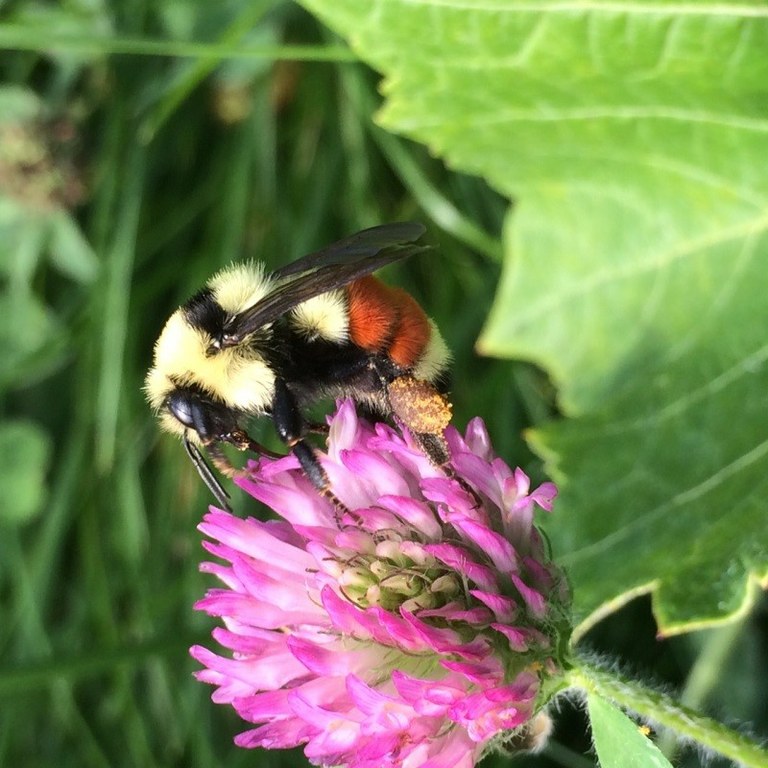
A Hunt bumble bee visits sweetclover, black-eyed Susan and thistle.
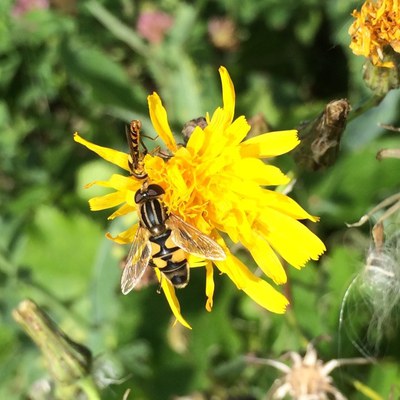
Two kinds of Syrphid flies. These are common hoverfly pollinators.
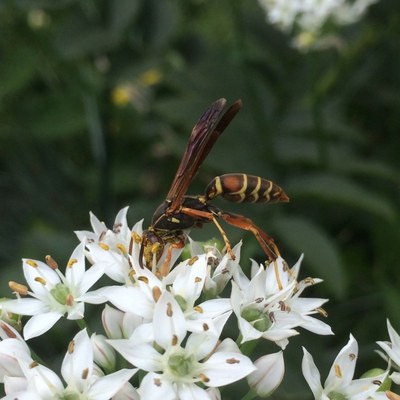
Northern paper wasp, Polistes fuscatus.
Kathy Wiederholt
Fruit Project manager
Planting Winter Rye Prior to Soybeans
Winter rye is an increasingly attractive option to plant ahead of soybeans. Some of the reasons include suppression of early season broadleaf weeds the following spring, firming saline soils prior to planting soybeans, and reducing wind and water erosion. Recently, one of the more challenging aspects of utilizing this strategy has been figuring out a way to get the rye established. Corn is the most commonly used rotational crop prior to soybeans in central and eastern ND. Many people have been broadcasting the seed by ground (early season) or by plane (late season) over the standing corn crop to get the rye seeded for soybeans the next year. If you missed that opportunity this season, do not fret. For the last two seasons we have been conducting a planting date experiment in Carrington.
Rye was no-till seeded with 4 or 5 late-season planting dates each year. Dates ranged from mid-Aug to early Nov. In 2014-2015, which had fairly hard winter conditions (cold temperatures with little or no snow cover), the rye was less vigorous, had less plants per acre, and had delayed maturity with each later planting date. However, the last planting date was Nov. 5th. The ground froze within a few days of planting, yet, the next spring roughly 60% of the plants emerged. Grain yield at that date was only half of the first planting as well. In 2015-2016, the differences in vigor and maturity were much less but there were still warm temperatures after our last planting date (Oct. 30th) that year.
Soybeans planted into rye that was hayed.
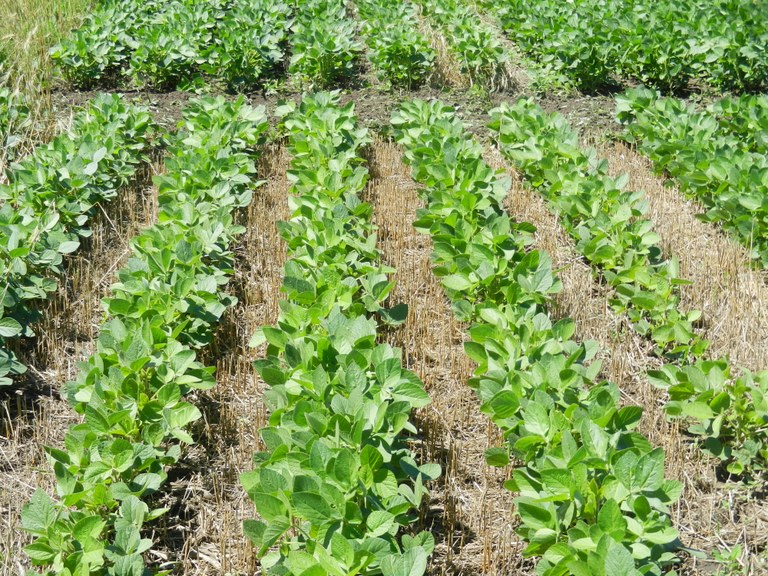
If the intended use is for terminating rye prior to soybean production, even these late planting dates have proven useful the last two years. This means that the rye could be planted after corn has been harvested, particularly in a year such as this when corn is likely to be harvested earlier than normal. Broadcasting rye seed can work, but it is dependent more-so on the weather. By planting the seeds into the ground, there is a better opportunity for the plants to germinate and grow.
Here are the pros and cons to late seeding rye:
| Pro | Con |
|---|---|
| Better soil-to-seed contact | Greater risk of winter kill |
| Better chance at successful establishment | Less erosion protection during fall/winter |
| Can plant after corn harvest | Less opportunity for grazing in fall/winter (also, delayed haying in the spring) |
Mike Ostlie, Ph. D.
Research Agronomist
“Why was Iron Deficiency Chlorosis (IDC) in soybean so bad in 2016?" What our teachers wrote.
Explaining the causes
- The soil contains plenty of iron (Fe) to satisfy soybean needs. But the Fe is not in the available form for plant uptake because high calcium carbonate in the topsoil keeps the soil pH at high levels (around 8). This favors Fe to remain in the insoluble and unavailable form.
- Extended periods of wet soils (from high water table, snowmelt, heavy rains) create conditions for less oxygen and more carbon dioxide (CO2) to accumulate in soil. CO2 is a precursor for bicarbonate production, which suppresses Fe solubility. Wet soils can also lead to excessive manganese uptake by crops. There is NO need to apply manganese fertilizer to fields in North Dakota in general, but especially not on soils giving IDC.
- Accumulation of excess soil nitrates on less productive, IDC susceptible spots. Excess nitrates intensify IDC. Use of cover crops, or planting a companion crop like oats or barley in spring has been suggested, to reduce soil nitrate levels and surface wetness.
- IDC is more severe in saline soils.
- Sometimes the seed you buy isn't as resistant as the seed company says. A simple suggestion is to compare the 5 to 10 weakest or most IDC-susceptible varieties in NDSU trials to the ratings by the respective seed companies and draw your conclusions.
The Teachers asked: “why was 2016 a “bad” chlorosis year?”
No single answer can explain the prevalence of IDC on a field. Some or all of the factors listed above were the primary causes of IDC in some of the fields in North Dakota. Any long period of drought may have caused higher loss of water from soil through plant uptake and loss from the leaves (evapotranspiration) than the soil received water from rainfall. This situation favors upward movement of soil water carrying salts with it.
Control measures
- Avoid fields that are susceptible to IDC. An attractive market price of $10/bu of soybeans that produced low yields on a susceptible field can be much less profitable than a 70 bu/ac barley crop that sells at $3/bu.
- Plant a resistant variety. Don’t rely solely on the seed company’s IDC ratings; Consider the NDSU IDC ratings as well, and talk to your neighbors too.
- Row spacing. There are indications that when dealing with IDC problems, it is more favorable to use 22 or 30” row spacing instead of 7”.
- Try barley cover crop at soybean planting: Consider broadcasting barley at about 1bu/ac, and lightly work it in; or seed with a two-compartment seeder unit. Kill the barley at 3-leaf stage when the soil is dry, or at 5-leaf when soil is wet.
- Use iron chelate (FeEDDHA). Apply 2 to 3 lb/ac of a proven product of FeEDDHA in-furrow at planting of a resistant soybean variety.
Read more on this article by Dr. D Franzen, and Dr. R Jay Goos in the Prairie Grains 2016 publication, issue 150.
Jasper Teboh, Ph. D.
Research Soil Scientist
How many hay bales do I need?
Estimating cow herd feed inventory requirements
The simple answer is that 6-9 round bales are needed to feed a cow over the winter. That’s one round bale of good quality hay per month. Assuming the round bale of hay weighs 1200 pounds, then one round bale per month should meet a non-lactating, pregnant cow’s feed requirements when consuming 40 pounds of hay daily for 30 days.
Grazing crop residue and swath grazing can reduce the number of round bales needed during the winter feeding season, but extended subzero weather can increase hay consumption and/or waste by 10-30%. It’s always a good plan to have a few extra bales available when poor weather conditions exist. Some managers will opt for 10% extra inventory while others secure a full extra year’s supply of hay inventory. Remember to include bulls and replacement heifers when estimating feed needs.
Early season 2016 hay production was diminished due to a lack of winter snow and minimal March and April rains, while late-season hay production was affected by too much rain. Good quality hay may be in limited supply but other hays and straws are solid options, as long as you remember that rain damaged hay, straw and stover have reduced feed values and need supplementation.
Usually energy is the limiting factor in poor-quality hay rations. Corn silage is an excellent source of energy with production yields ranging from 10-25 ton per acre (depending on variety, fertility, soil, rain, etc.). If extra feed energy is needed for wintering the cow herd, then 10 acres of 18 ton/acre corn silage should provide enough energy to feed 150 cows for one month when fed 18 pounds TDN per day. As an energy substitute, 2 pounds of corn silage replaces 1 pound of hay. (corn silage: 35% dry matter, 65% TDN DM; hay: 85% dry matter, 50% TDN DM).
Many co-product feeds are readily available in North Dakota. Distillers grains, wheat midds, barley malt sprout pellets, beet pulp, and tailings. As an energy substitute, 0.4 pounds of dried distillers grains replaces 1 pound of hay (DDGS: 92% dry matter, 86% TDN DM).
Count your hay bales, be sure to test for quality, then supplement as needed.

Karl Hoppe, Ph. D.
Area Extension Livestock Specialist
Informal Center Tour
The Carrington Research Extension Center will host another informal community tour at 7:00 p.m. on Tuesday, August 30.
Local staff will host the tours, and, while subject matter experts may be available to answer detailed questions, these tours are designed for a general audience, to provide an overview of the variety of research and projects conducted at the CREC.
A brief history of the Center, along with descriptions of the types of research conducted and the variety of grains, fruits, and livestock represented, will be described on the rolling tour.
One of our iconic yellow tour wagons will be used to transport participants -- space is therefore limited to 25-30 people. Reserve your space by calling the Carrington REC at 701-652-2951.

Participants are asked to gather at the Main Building of the CREC, located at 663 Highway 281 NE (3.5 miles north of Jct. 200/281) between 6:30 p.m. and 7:00 p.m. The wagon will leave the yard at 7:00 p.m., and the tour will last approximately 1.5 hours. Bring your own insect repellent, sunscreen, water, etc., and dress for the weather. Photographers are welcome!
Linda Schuster
Administrative Secretary
Carrington Row Crop Tour Set for Aug. 25
Farmers, crop advisers and agricultural industry representatives will have an opportunity to view field research trials and receive production recommendations on corn, soybeans and dry edible beans at a field tour on Thursday, Aug. 25, at the NDSU Carrington Research Extension Center.
Registration (with refreshments) will start at 4 p.m. and the tour will begin promptly at 4:30.
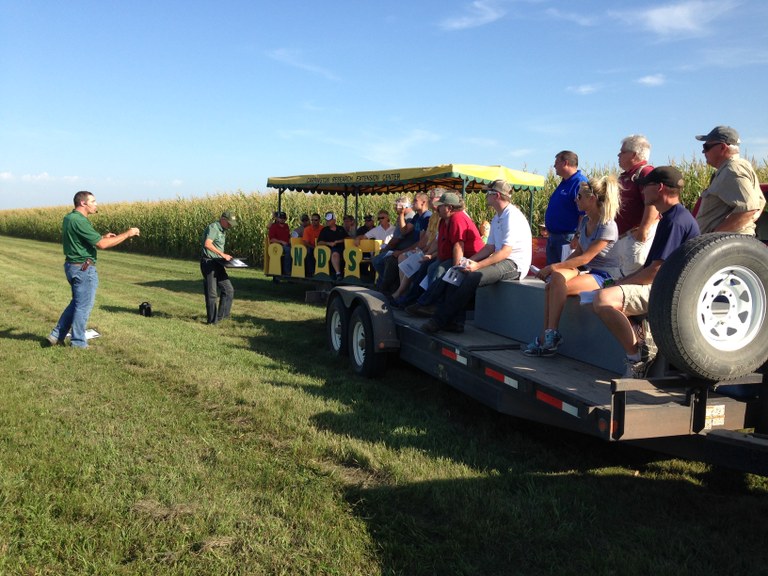
Tour topics are:
- Best combination of corn hybrid relative maturity and plant populations
- Corn end-of-season plant development and management
- Soybean variety selection and planting dates
- NDSU dry bean breeding program and 2016 production updates
- Dry bean plant establishment and nutrient management
- Overview of soybean and dry bean disease management, with an emphasis on white mold and soybean cyst nematode
- Review of research on improving foliar fungicide coverage and dry bean seed treatment
Tour speakers include NDSU Extension Service specialists and North Dakota Agricultural Experiment Station scientists Juan Osorno, dry bean breeder; Greg Endres, Hans Kandel and Mike Ostlie, agronomists; and Sam Markell and Michael Wunsch, plant pathologists.
A supper sponsored by associated North Dakota commodity organizations will follow the tour.
Continuing education credits will be available for certified crop advisers participating in the event.
Additional information about the tour is available from the Carrington center at 701-652-2951 or https://www.ag.ndsu.edu/CarringtonREC.
Greg Endres
Area Extension Specialist/Cropping Systems


